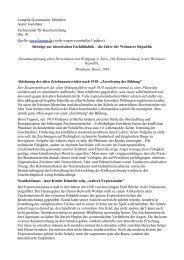Research in Visual Arts Education - The National Society for ...
Research in Visual Arts Education - The National Society for ...
Research in Visual Arts Education - The National Society for ...
You also want an ePaper? Increase the reach of your titles
YUMPU automatically turns print PDFs into web optimized ePapers that Google loves.
MEDIATED ACTION AND AESTHETIC LEARNING<br />
the <strong>in</strong>tegration of art with subject matter from other discipl<strong>in</strong>es (Cornett,<br />
2003, Ch. 5), but it may also serve as a rem<strong>in</strong>der of the fact that art works<br />
tend to have a content beyond themselves, some <strong>in</strong>tentions with which they<br />
are expected to “fit” (Goodman, 1978). Learn<strong>in</strong>g ABOUT refers to the basics<br />
of art education, from the elements and pr<strong>in</strong>ciples of design to knowledge<br />
about artists, styles and genres. Learn<strong>in</strong>g IN refers to experiment<strong>in</strong>g with<br />
materials and techniques <strong>in</strong> order to achieve a visual effect, convey a message<br />
or express a mood. Learn<strong>in</strong>g THROUGH, f<strong>in</strong>ally, refers to the “studio<br />
habits of m<strong>in</strong>d” (Hetland, W<strong>in</strong>ner, et al., 2007) or th<strong>in</strong>k<strong>in</strong>g dispositions that<br />
we might acquire by <strong>in</strong>volv<strong>in</strong>g ourselves <strong>in</strong> art projects.<br />
<strong>Research</strong> methods and reported outcomes<br />
Like <strong>in</strong> many other fields of outcome research, there tends to be a paradoxal<br />
relationship between the quality of the research methods applied and<br />
the reported outcome of the <strong>in</strong>tervention that is be<strong>in</strong>g studied. <strong>The</strong> less<br />
rigorous the design of an evaluative study, the more favourable results tend<br />
to be reported. This relationship is found especially <strong>in</strong> situations where a<br />
favourable outcome is a requirement <strong>for</strong> further fund<strong>in</strong>g.<br />
<strong>The</strong> positive effects of <strong>in</strong>vestment <strong>in</strong> cultural capital, <strong>for</strong> example through<br />
visit<strong>in</strong>g artists, are often taken <strong>for</strong> granted. A report by a team of researchers,<br />
co-ord<strong>in</strong>ated by Mats Trondman (1996), described the prevail<strong>in</strong>g attitude to<br />
cultural projects <strong>in</strong> school <strong>in</strong> the follow<strong>in</strong>g terms: there exists someth<strong>in</strong>g<br />
unproblematic good that cannot be questioned; that “goody” is the nice,<br />
that is, uncontroversial culture. And s<strong>in</strong>ce culture is nice, it will result <strong>in</strong><br />
someth<strong>in</strong>g nice as well. But not only <strong>in</strong> nice “art works” but also <strong>in</strong> all sorts<br />
of nice th<strong>in</strong>gs, such as enhanced self-esteem, improved peer relationships,<br />
and active leisure-time activities (Hansson & Sommansson, 1998, pp. 26-27).<br />
Un<strong>for</strong>tunately, such transfer from one doma<strong>in</strong> to another has been very<br />
difficult to verify. Ellen W<strong>in</strong>ner and Monica Cooper (2000; L<strong>in</strong>dström,<br />
2002a) identified 1,135 studies that l<strong>in</strong>ked creative arts to academic achievement,<br />
that is success <strong>in</strong> English, Math, etc. After apply<strong>in</strong>g a set of strict<br />
<strong>in</strong>clusion criteria, they were left with 31 useable studies, from which they<br />
calculated 66 effect sizes. To be <strong>in</strong>cluded, studies had to be either experimental<br />
or correlational, with a comparison or control group. Hence, pretestposttest<br />
studies of a s<strong>in</strong>gle group were not <strong>in</strong>cluded. It was noted, however,<br />
that such studies produced effect sizes that were more than six times larger<br />
than those of well-designed studies. No experimental study, on the other<br />
hand, has so far been able to demonstrate that study<strong>in</strong>g the arts leads to<br />
improved academic per<strong>for</strong>mance.<br />
NORDIC VISUAL ARTS EDUCATION IN TRANSITION 67



